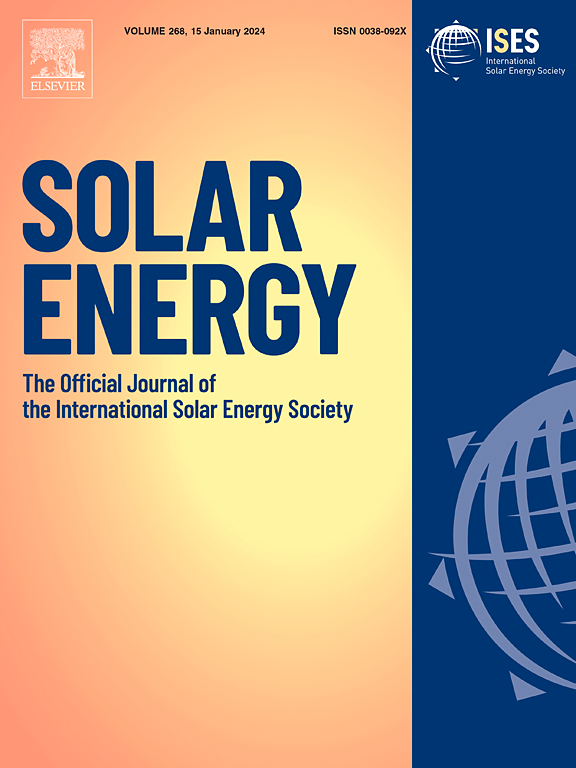Impacts of 2019–20 Australian bushfires on solar photovoltaic generation using high-resolution simulations
IF 6
2区 工程技术
Q2 ENERGY & FUELS
引用次数: 0
Abstract
As a key component of the clean energy transition, solar photovoltaic (PV) generation is expanding rapidly. Atmospheric aerosols affect solar resources, reducing usable radiation and decreasing PV potential. To investigate the aerosols role on Australian PV potential, the WRF-Solar model is used to simulate the 2019 climate, focusing on the summer bushfire season. Four experiments with different aerosol configurations were conducted, in a 10-km grid spacing domain in continental Australia and a 2-km nested domain over New South Wales. The control experiment (no aerosols) is compared with three experiments that incorporate climatological and time-varying aerosol optical depth (AOD) from the Modern-Era Retrospective Analysis for Research and Applications Version 2 (MERRA2) and Himawari-8 satellite. The results of the simulated global horizontal irradiance (GHI) and direct normal irradiance (DNI) are evaluated against observations. The resultant PV power potential for each experiment is estimated using a resource-to-power conversion model. During the bushfire season, the inclusion of MERRA2 AOD significantly improved the simulation of solar irradiance, especially the DNI, compared to ground stations (up to 83% bias improvement) and satellite-derived irradiance (up to 18% improvement in the root mean square deviation). The inclusion of Himawari-8 AOD data is also beneficial, but its spatio-temporal coverage is highly limited due to the large number of gaps from cloudy pixels. Reductions of up to 16% in the PV power potential were evident in the experiment including MERRA2 3-hourly AOD compared to the control experiment, demonstrating the importance of including time-varying aerosols when simulating the PV energy production.
利用高分辨率模拟 2019-20 年澳大利亚丛林大火对太阳能光伏发电的影响
作为清洁能源转型的关键组成部分,太阳能光伏发电(PV)正在迅速扩大。大气气溶胶会影响太阳能资源,减少可用辐射,降低光伏发电潜力。为了研究气溶胶对澳大利亚光伏发电潜力的影响,我们使用 WRF-Solar 模型模拟了 2019 年的气候,重点关注夏季丛林火灾季节。在澳大利亚大陆的 10 千米网格间距域和新南威尔士州上空的 2 千米嵌套域中,进行了四次不同气溶胶配置的实验。对照实验(无气溶胶)与三个实验进行了比较,这三个实验采用了现代研究与应用前瞻性分析 2 版(MERRA2)和 Himawari-8 卫星的气候和时变气溶胶光学深度(AOD)。模拟的全球水平辐照度(GHI)和直接法线辐照度(DNI)结果与观测结果进行了对比评估。利用资源-电力转换模型估算了每次实验的光伏发电潜力。在丛林火灾季节,与地面站(偏差改善达 83%)和卫星辐照度(均方根偏差改善达 18%)相比,MERRA2 AOD 的加入显著改善了太阳辐照度的模拟,尤其是 DNI。纳入 Himawari-8 AOD 数据也有好处,但由于云雾像素造成的大量空白,其时空覆盖范围非常有限。与对照实验相比,在包含 MERRA2 3 小时 AOD 的实验中,光伏发电潜力明显降低了 16%,这表明在模拟光伏发电时包含时变气溶胶的重要性。
本文章由计算机程序翻译,如有差异,请以英文原文为准。
求助全文
约1分钟内获得全文
求助全文
来源期刊

Solar Energy
工程技术-能源与燃料
CiteScore
13.90
自引率
9.00%
发文量
0
审稿时长
47 days
期刊介绍:
Solar Energy welcomes manuscripts presenting information not previously published in journals on any aspect of solar energy research, development, application, measurement or policy. The term "solar energy" in this context includes the indirect uses such as wind energy and biomass
 求助内容:
求助内容: 应助结果提醒方式:
应助结果提醒方式:


